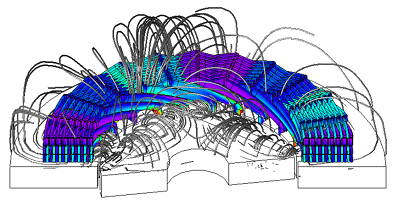Contents
1. Introduction
2. Differences in stray load loss depending on driving conditions
3. Issues of stray load loss analysis
4. Stray load loss analysis modeling
5. Summary
6. References
1. Introduction
The main components of loss depend on the operating point. One of these components is stray load loss. The stray load loss as a physical phenomenon is caused by eddy currents generated in the parts inside equipment, but unlike iron loss, copper loss, and mechanical loss, the locations of occurrence are not clear. In many cases, eddy currents generated in magnets, model edges, press rings, etc. are a problem. In addition, the stray load loss is often caused by leakage flux, main magnetic flux, space harmonics, and time harmonics. As the equipment tend to be downsized and are aiming for higher efficiency, there is a possibility that the stray load loss becomes the accuracy error for loss analysis, and thus this loss is considered a non-negligible component.
2. Differences in stray load loss depending on driving conditions
The contribution of the stray load loss on the whole loss varies depending on the driving condition. Here magnet eddy current loss is studied as an example. Harmonic components, that cause a loss by being linked to the magnet, differ depending on the drive conditions and therefore need to be evaluated over a wide range. As an example, IPM motor magnet eddy current loss is considered. Fig. 1 and Table 1 show the motor and its driving conditions. Each loss component’s contribution is compared for different drive conditions (current phases) in Fig. 2. It is seen that the magnetic eddy current loss ratio varies depending on the drive condition. It is found that the stray load loss depends on the time harmonic components due to magnetic saturation of the device and the drive influence.

Motor geometry

Coil eddy current loss of rectangular coil
Eddy currents are generated in the stator surface, press ring, coil, etc. due to magnetic flux across the gap and leakage magnetic flux from the coil ends. Large-scale three-dimensional analysis is required to capture complex leakage flux, but this is possible to do in a short time using an MPP solver.
You need to sign in as a Regular JMAG Software User (paid user) or JMAG WEB MEMBER (free membership).
By registering as a JMAG WEB MEMBER, you can browse technical materials and other member-only contents for free.
If you are not registered, click the “Create an Account” button.
Create an Account Sign in



